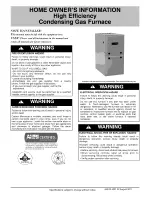
5165697-BUM-C-0818
4
Johnson Controls Unitary Products
HOW YOUR GAS FURNACE WORKS
Your furnace is a very easy appliance to take for granted. Season after
season, it sits there in your home, keeping you warm and comfortable.
For this reason, you may never have given much thought to the way
your furnace operates. In order to get the safest and most efficient oper-
ation from your furnace, you should understand how your furnace does
its job.
When you set your thermostat to provide more heat in your home, you
are starting the heating cycle of the furnace. First, the inducer motor
starts to purge the heat exchanger of any remaining gases. Next, the
hot surface ignitor glows and after a warm-up period the gas valve
opens and ignition occurs. A short time later, the blower starts and dis-
tributes the warm air throughout the home. When the temperature set-
ting on your thermostat is reached, the gas valve closes, the main
burner is turned off, and the blower continues to run until the remaining
warm air in the system is distributed. When the blower stops, the heat-
ing cycle has ended.
IF FURNACE FAILS TO OPERATE PROPERLY
1. Check setting of thermostat - and position of heat/cool switch if air
conditioning is installed. If a set-back type thermostat is employed
be sure that the thermostat is in the correct operating mode.
2. Check to see that electrical power is “ON”.
3. Check to see that the lever or switch on the gas control valve is in
the full “ON” position.
4. Make sure filters are clean, return grilles are not obstructed, and
supply registers are open.
5. Be sure that furnace flue piping is open and unobstructed.
When You Call For Service Assistance
Very often time can be saved if you will give the service agency the
MODEL and SERIAL NUMBER of your furnace. This will enable him to
determine the specific components used, and perhaps to better identify
the possible problem and be better prepared if a service call is required.
To Contact Your Serviceman
(fill in)
COMPANY: ______________________________________________
ADDRESS: ______________________________________________
TELPHONE: _____________________________________________
All appliances need maintenance by serviceman at the beginning of
each heating season. Call your nearest authorized service technician
to:
1. Replace filters. Clean all lint and dust from around furnace.
2. Remove fan and clean all dust and lint from unit with stiff bristle
brush.
3. Inspect combustion chamber, the transition into the blower compart-
ment, flue collar, and roof jack.
4. Check the gas valve and line connections for leaks.
5. Make any adjustments necessary for good operation.
SAFETY INFORMATION
Read the Instructions Below Before Trying to Start the
Furnace
1. This appliance does not have a pilot. It is equipped with an ignition
device which automatically lights the burner. Do not try to light the
burner by hand.
2. BEFORE OPERATING; smell all around the appliance area for gas.
Be sure to smell next to the floor because some gas is heavier than
air and will settle on the floor.
3. Use only your hand to push the gas control switch to the “on” posi-
tion. Never use tools. If the switch will not operate by hand, don’t try
to repair it, call a qualified service technician. Force or attempted
repair may result in a fire or explosion.
4. Do not use this appliance if any part has been under water. Immedi-
ately call a qualified service technician to inspect the appliance and
to replace any part of the control system and any gas control, which
has been under water.
START-UP AND SHUTDOWN INSTRUCTIONS
Operating Instructions:
1. STOP! Read the safety information above.
2. Set the thermostat to the lowest setting.
3. Turn off all electric power to the appliance.
4. Remove furnace door.
5. Move gas control switch to the “OFF” position. Do not force. See
Figure 4.
6. Wait five (5) minutes to clear out any gas. If you then smell gas,
STOP! Follow Step 2 (refer to Safety Information on Page 4). If you
don’t smell gas, go to next step.
7. Move gas control switch to the “ON” position. Do not force. See Fig-
ure 4.
8. Replace burner door.
9. Turn on all electric power to the appliance.
10. Set thermostat to the desired setting. Burner will light, which may
take 30-60 seconds.
11. After three (3) trials for ignition, if the appliance will not operate fol-
low the instructions, “TO TURN OFF THE APPLIANCE” and call
your service technician or gas supplier.
FIGURE 3:
Furnace Examination Checkpoints
([DPLQH9HQW3LSH
([DPLQH)LOWHU'RRU
5HPRYH)LOWHU
'RRUWR([DPLQH
&RPEXVWLRQ$LU3LSH
([DPLQH%XUQHU'RRU
5HPRYH%XUQHU
'RRUWR([DPLQH
)XUQDFH%DVHDQG
$LU&RQGLWLRQLQJ
&RLO3DQHOV
5HPRYH%XUQHU
'RRUWR([DPLQH
%XUQHU)ODPH
$
NOTICE
The coil panel provides a good removable access for inspecting
inside the furnace casing. Smoke or reflected light inside the casing
indicates the presence of leaks in the heat exchanger.
WARNING
If you do not follow these instructions exactly, a fire or explosion may
result causing property damage, personal injury, and/or loss of life.
!



























